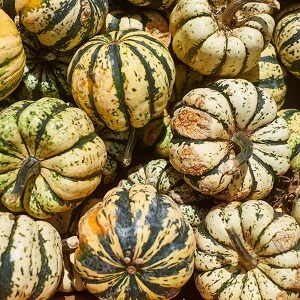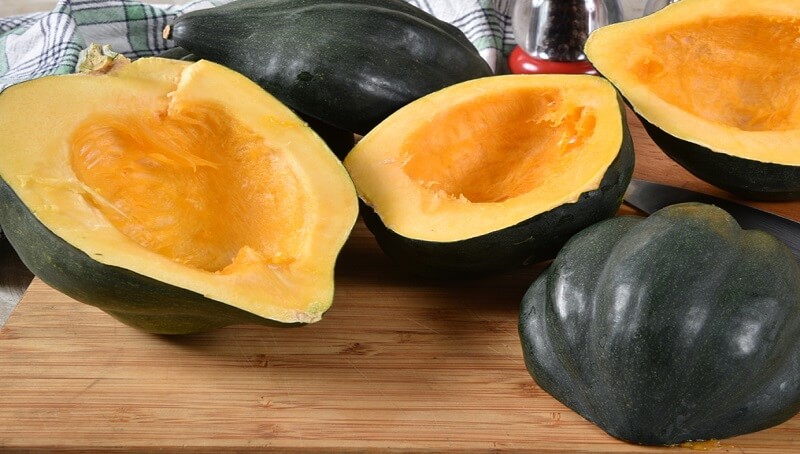A lot of people add acorn squash into their recipes at one point or another, to try to add some variety to meals. The problem is that not a lot of people know how much acorn squash to get from the market for a certain recipe. While some soup recipes call for mashed squash, others would need 2 cups of cooked acorn squash or even 3 cups of cubed squash. But first off let’s find out how much will a whole acorn squash weigh and how will this relate to buying these products from the store.
As we’ve done for many products in the past, we took it on ourselves to see how much acorn squash you’d need for different recipes, so we went straight to the grocery store to see what the produce section had to offer. The acorn squash is usually pretty round and small compared to other types of winter squash. It will usually have a diameter of around 4 – 5 inches across, while its weight will be somewhere between 1 pound and a half and 2 pounds. For our test, we went for what we considered an average acorn squash, with a size of 1½ pounds.
 You will notice some very distinct ribs running on the length of the skin of the acorn squash, which is golden-yellow or blackish-green in color, and although they are thin, they are inedible. This is why they will have to remove them before adding this squash to any recipe. When you cook it, it will become mildly sweet and soft and will have a great buttery flavor.
You will notice some very distinct ribs running on the length of the skin of the acorn squash, which is golden-yellow or blackish-green in color, and although they are thin, they are inedible. This is why they will have to remove them before adding this squash to any recipe. When you cook it, it will become mildly sweet and soft and will have a great buttery flavor.
The weight of the acorn squash will decrease after you remove the skin and the seeds by almost half a pound. We also noticed that when cooked the acorn squash fits in about 2 cups, while cubed, it would fill around 3 and a half cups. This volume decreases even more, to about 1 cup, when you mash it instead.
So let’s break down the math: If you wanted to serve 4 people with just half a cup of acorn squash, then you would have to purchase one medium size squash of around 1 pound and a half to make it into cubes, or two squashes if you wanted to either offer mashed or cooker portions.
Acorn squash is a pretty old food type, being used since 4,000 B.C. by people who used to cook it in outdoor clay and brick ovens. It is also called Danish squash. When you are faced with hard-to-cut acorn squash, you can try to either microwave, steam, or bake it whole for around 3 minutes. This will make it softer just enough so it is easy to cut.
You might also like our articles on the weight of butternut squash, corn, or sweet potato.
If you want to get the perfect acorn squash from the store, then go for one that feels rather heavy to the touch, especially for its size. It should also be one that is firm to the touch. You should also get one that has dull-looking skin, smooth to the touch, and is free of any bruises. It shouldn’t have shiny skin either because this can be a sign that it might have been picked a little too early.
So by now, you should have a pretty good idea of how much squash you will actually need regardless of whether you need it pureed or cubed. If you’re still having difficulties converting squash, you can always use the conversion tool we provide to make things easier.
Info on the general winter squash
The following vegetables belong to the winter squash family: Turban, Sweet dumpling, Spaghetti, Kabocha, Hubbard, gold Nubbet, Fairytale Pumpkin, Peanut (Delicata), Buttercup, Butternut, Banana, Autumn Cup, Amber cup and Acorn squashes.
How to store can squash
Go for squashes that have thick shells and are fairly heavy for their actual size. If you find some with cuts or soft spots in the shell or any signs of decay, avoid them, they will go bad faster.
Long Term Acorn Squash Storage
Before squeezing winter squash, make sure you first wash it, then cut it into smaller pieces, and then remove the peel and seeds. You then cook it until it gets soft and they mash pulp or using a sieve. Wait until it is cooled and then place it in an airtight freezer container. Add ½ inch of head space and then freeze everything at 0°F (-17.8°C). In this way, you can keep the squash for close to a year.
Short Term Acorn Squash Storage
You can store acorn squash unwashed and whole in cool 50 to 55°F (10 to 12.8°C) places that are dry enough. These can be anything from a garage to a basement. Kept this way, it will last for around 3 to 4 months. Keep in mind that this time will be reduced by warmer temperatures.
You can also keep cut squash pieces for up to 5 days if you refrigerate them and then place them in an airtight plastic container. Cook squash, on the other hand, will only last for up to a week and should be stored in the refrigerator.
